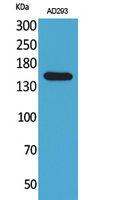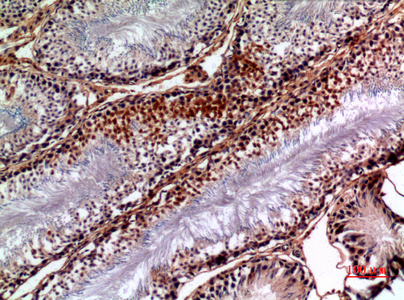产品名称
NTE Rabbit Polyclonal Antibody
别名
PNPLA6; NTE; Neuropathy target esterase; Patatin-like phospholipase domain-containing protein 6
蛋白名称
Neuropathy target esterase
存储缓冲液
Liquid in PBS containing 50% glycerol, 0.5% BSA and 0.02% New type preservative N.
Human Gene Link
http://www.ncbi.nlm.nih.gov/sites/entrez?db=gene&term=10908
Human Swissprot No.
Q8IY17
Human Swissprot Link
http://www.uniprot.org/uniprotkb/Q8IY17/entry
Mouse Gene Link
http://www.ncbi.nlm.nih.gov/sites/entrez?db=gene&term=50767
Mouse Swissprot No.
Q3TRM4
Mouse Swissprot Link
http://www.uniprot.org/uniprot/Q3TRM4
免疫原
The antiserum was produced against synthesized peptide derived from the Internal region of human PNPLA6. AA range:1031-1080
特异性
NTE Polyclonal Antibody detects endogenous levels of NTE protein.
稀释度
WB 1:500 - 1:2000. IHC-p: 1:100-1:300. ELISA: 1:20000.. IF 1:50-200
宿主
Polyclonal, Rabbit,IgG
背景介绍
This gene encodes a phospholipase that deacetylates intracellular phosphatidylcholine to produce glycerophosphocholine. It is thought to function in neurite outgrowth and process elongation during neuronal differentiation. The protein is anchored to the cytoplasmic face of the endoplasmic reticulum in both neurons and non-neuronal cells. Mutations in this gene result in autosomal recessive spastic paraplegia, and the protein is the target for neurodegeneration induced by organophosphorus compounds and chemical warfare agents. Multiple transcript variants encoding different isoforms have been found for this gene. [provided by RefSeq, Oct 2009],
组织表达
Expressed in brain, placenta, kidney, neuron and skeletal muscle. Expressed in the developing eye, pituitary and brain.
细胞定位
Endoplasmic reticulum membrane ; Single-pass type III membrane protein .
功能
catalytic activity:2-lysophosphatidylcholine + H(2)O = glycerophosphocholine + a carboxylate.,disease:Defects in PNPLA6 are the cause of spastic paraplegia autosomal recessive type 39 (SPG39) [MIM:612020]; also known as NTE-related motor neuron disorder (NTEMND). Spastic paraplegia is a neurodegenerative disorder characterized by a slow, gradual, progressive weakness and spasticity of the lower limbs. Rate of progression and the severity of symptoms are quite variable. Initial symptoms may include difficulty with balance, weakness and stiffness in the legs, muscle spasms, and dragging the toes when walking. In some forms of the disorder, bladder symptoms (such as incontinence) may appear, or the weakness and stiffness may spread to other parts of the body. SPG39 is associated with a motor axonopathy affecting upper and lower limbs and resulting in progressive wasting of distal upper and lower extremity muscles.,enzyme regulation:Inhibited by a series a OPs such as mipafox (MPX), phenyl saligenin phosphate (PSP), phenyl dipentyl phosphinate (PDPP), diisopropyl fluorophosphate and paraoxon.,function:Phospholipase B that deacylates intracellular phosphatidylcholine (PtdCho), generating glycerophosphocholine (GroPtdCho). This deacylation occurs at both sn-2 and sn-1 positions of PtdCho. Its specific chemical modification by certain organophosphorus (OP) compounds leads to distal axonopathy.,PTM:Glycosylated.,similarity:Belongs to the NTE family.,similarity:Contains 1 patatin domain.,similarity:Contains 3 cyclic nucleotide-binding domains.,subcellular location:Anchored to the cytoplasmic face of the endoplasmic reticulum by its amino-terminal transmembrane segment.,tissue specificity:Expressed in brain, placenta, kidney, neuron and skeletal muscle.,
纯化
The antibody was affinity-purified from rabbit antiserum by affinity-chromatography using epitope-specific immunogen.


.jpg)
.jpg)

